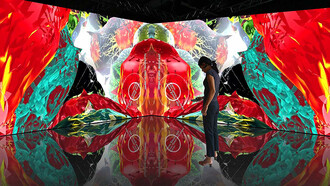While I was growing up in Montana, I experienced some of the pristine natural environment that still remained there. I spent time hiking, backpacking, skiing, and fishing in wilderness areas throughout the state. As one of the largest states in the U.S. with one of the smallest populations, Montana’s natural resources have been the primary source of income and economic development in the state. From the Wild West to the contemporary tourism and natural resources industries, Montana epitomizes many of the changes in the American myth and reality.
In many ways Montana symbolizes the history of the American taming of the wilderness, from the exploitation of natural resources (for example, the gold and copper-mining town of Butte, “The Richest Hill On Earth”, oil and gas development, coal mining, timber) and agri-business to more contemporary industries (large hydroelectric projects, military installations, tourism). But Montana is also primarily a rural and agricultural state, a throwback to an earlier era in American culture. And it has the potential (as yet unrealized) to be at the forefront of a new generation of sustainable energy, resource technologies, and agricultural practices.
As I gradually became aware of the increasing degradation of the environment in Montana, I began to think more about the Native Americans’ notion of the Seventh Generation (specifically formulated in The Great Law of the Iroquois): that all actions and decisions should be guided by the principle of their impact on the seventh generation into the future.
A similar principle has motivated the Aboriginal tribes of Australia, the Earth’s oldest known continuous civilization, dating back 40,000 years. An Aboriginal tribal elder, when asked why his culture had left behind no structures that compared with the Pyramids, the Parthenon, or other great monuments of recent civilizations, replied that his people had strived to leave the land just as they had found it: that was their most enduring monument.
After 20 years of investigating the contemporary American wasteland, I wanted to create what Wallace Stegner called a “geography of hope.” I gradually found my way to making photographs of the sacred landscape, documented in my new book, The Cloud of Unknowing. In a certain sense, this work came out of a photograph that I made in 1984 of the pulpit of the First Baptist Church in the factory town of Colstrip, Montana, which is home to one of the largest coal strip-mines in North America. That image was so different from the others in the series in both form and content—it seemed like a clue to something.
Years later, I began to make photographs of early and abandoned missionary churches on Native American reservations in Montana, and of New Age religious communes in Montana and elsewhere. At first, these images were tangential pictures made on my travels in pursuit of my “primary” photographic work, but in time they grew into The Cloud of Unknowing.
In The Cloud of Unknowing, I have explored what has been created when imagination, affection, and a sacred sense of one’s place within the cosmos inform human activity. In contrast to the toxic monuments to our carelessness, greed, and deceit, the shrines portrayed in this book represent some of the best works of human creativity. They are monuments to the human spirit and all that it holds most sacred.















